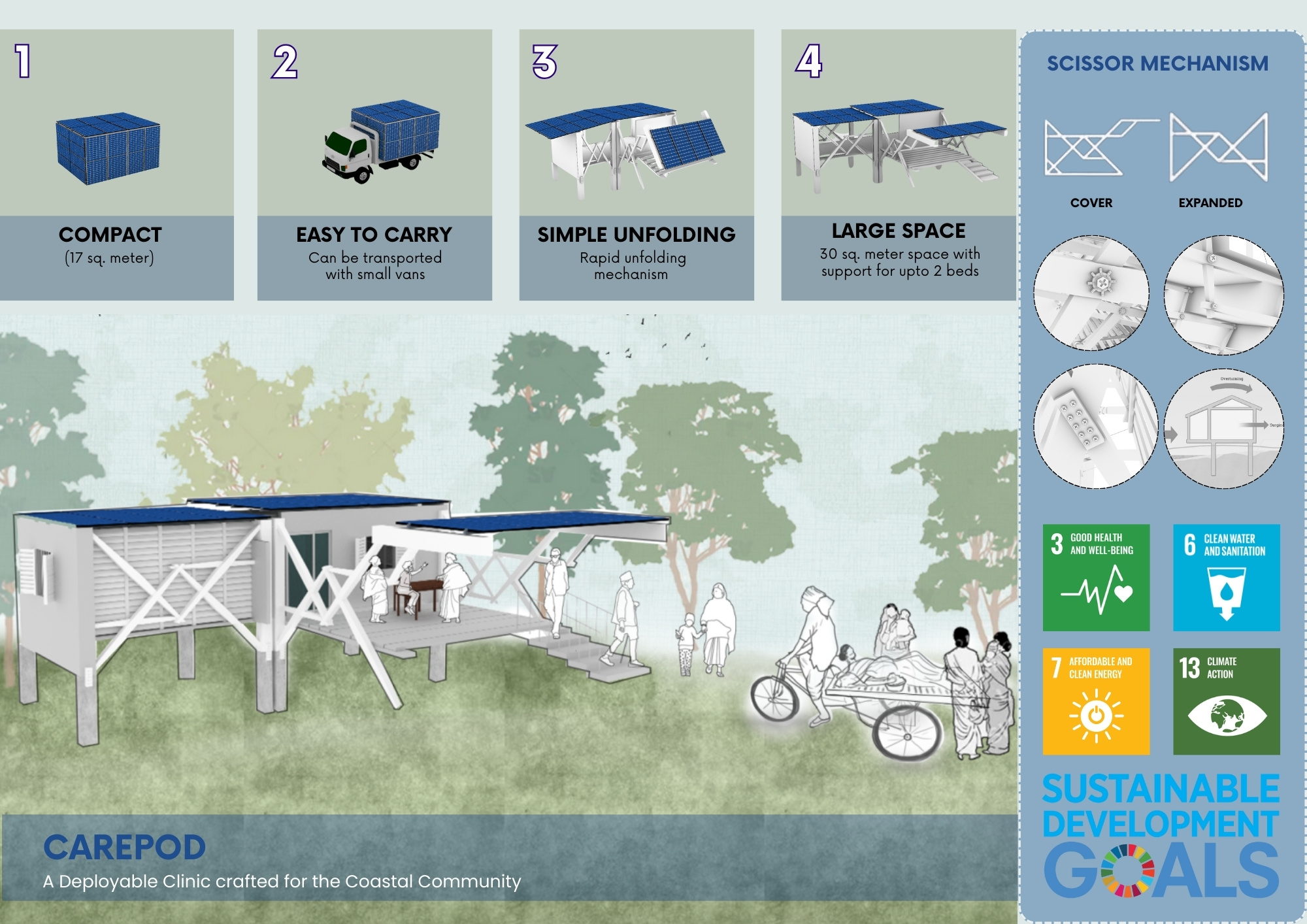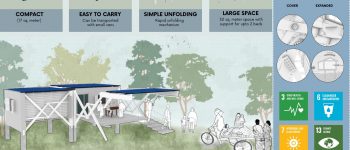We propose Carepod- a deployable, disaster-resilient clinic crafted for the coastal community. It can be kept in a compact state before deployment, which is easy and suitable for transportation to the target location. There, it can be rapidly unfolded, and in the deployed state, it is as good as any other community clinic.
scissor mechanisms will be used for deployment and contraction. Stilts will be used for minimal disruption of natural habitats as well as to ensure a minimal carbon footprint.
We have also thought about some other features like water gutters for rainwater harvesting, which is a common practice in the coastal area. The solar panels can be handy during power outages owing to the turbulent weather and insufficient power supply to the coastal areas. Also, universal accessibility is something that is often forgotten in rural projects, but not in this case.
Color bond ultra steel can be used for roofs, walls, and downpipes. The reverse osmosis Tetra Filters should be used in this case, made by Tetra, who also happens to be one of our key advisors! In coastal areas, salinity is a huge issue. So pure drinking water is actually as vital and scarce as medicines. That is why, even in the existing model, the existing community clinics sell drinking water at 2 tk per liter. So we aim to focus there too.
We aim to conform to a marketing policy that blends the traditional below-the-line and above-the-line strategy with modern TTL(through-the-line) strategies. We will partner with banks and other corporate houses that have invested in similar projects as part of their CSR-corporate social responsibility activity. IDCOL has already taken the initiative to establish 18000 solar-powered community clinics. It has also been a very long time since Standard Chartered Bank focused on coastal development and started investing there heavily. These could all be our potential partners.
Our sales channel will be predominantly reliant on integration into government projects, as coastal healthcare and community clinics are primarily provisioned by the government. We will use the government apparatus for social welfare and public health-related promotions. We will invite the government for collaboration by promoting the positive impacts we can have.
However, community clinics are managed and maintained by the local community. So we will also aim to fetch at least one-tenth of our sales fromthe B2C channel.
All of these marketing, collaboration, and negotiation will be based on the positive impact we can bring into the lives of the impoverished, underprivileged coastal people. We will contribute to both mitigation and adaptation. By providing a substitution for in-situ construction, we save the coastal environment from the infamous, corrosive waste generated during construction. In normal times, our structures co-exist more with nature and obstruct natural processes far less than permanent structures. But that is just the beginning. In the toughest of situations, we contribute to adaptation to inevitable disasters. Our carepods can be shifted easily to places of population influx during disasters and thus can save people as well as their own durability from the wrath of nature.
The carepods are reliable during normal times and resilient, even during the worst weather.
Carepods are holistic solutions for the people living in coastal regions. Carepods provide opportunities for employment, treatment and environmental sustenance. Every community clinic provides a job prospect for 15-20 coastal residents. The carepods provide basic healthcare facilities, just like community clinic effectively does. It is not intended to tinker with the healthcare-providing facility. Rather, our team focuses on making the healthcare structures less harmful and more responsive to nature. This is how we aim to support and improve the lives of climate refugees.
Of course, it’s a very bold dream that must be backed up by a very passionate team. Our team behind this idea and vision of Carepod is a multi-disciplinary team consisting of individuals from different disciplines. We have students from the Department of Architecture, Civil Engineering, Computer Science and Industrial & Production Engineering.
This cross-disciplinary team is what fuels our aspirations, and we have been busy for quite a long time, we have been awarded 50,000 BDT by ICCCAD initially for further rectification of our idea and market research. We have collaborated with Tetra for 6 months now, learning how to survive in a very dynamic, multi-objective circumstance. We know that this is just the beginning, and we have a long way to go.
But that is exactly what inspires us more! Carepods have the potential to have a massive impact on the lives of people, covering crucial SDGs like 3,6, 7, and 13. We aim to provide healthcare facilities to that portion of our population, who are the most unprivileged, deprived and destitute.
The hospitals in coastal areas have increased vulnerability to storms, floods, and other natural disasters.
This exposure is further increased due to the adverse impacts of climate change, resulting in aggravated frequencies of natural calamities. Whenever these calamities strike, people become injured, water-borne diseases spread, epidemics like diarrhea, and cholera are imminent…In short, this is when people need healthcare most.
However, this is when healthcare becomes scarce. And as a consequence, people suffer direly. The coastal healthcare system is a paradox. You won’t find it when you need it most.
Moreover, even on normal days, 6 out of 10 people living in coastal areas do not have access to upazila health clinics and other healthcare facilities. Even 30% of people are deprived of the service of community clinics.
To sum up, the healthcare system in coastal areas is inadequate in normal times and incompetent in handling adversity.
Adding the last nail in the coffin, the infrastructure of coastal healthcare facilities has serious implications for the environment. Due to the unique topography of coastal regions, the buildings need deeper foundations, further increasing the impacts of climate change.
How do we plan to solve this?
We build something that is resilient in disasters, and sensitive to the unique ecology of the coastal environment.
Imagine a structure that can adapt, withstand disasters, and support the local ecosystem—a new concept of healthcare for coastal areas. Our vision is a movable, modular, and semi-permanent structure tailored to serve coastal communities in their most vulnerable moments.
1) Underprivileged people living in the disaster-prone coastal region, 2) Expecting and new mothers who are in constant need of health checkups and basic healthcare, 3) Young children who require vaccines, regular check-ups etc.
Our key collaborators will be 1) Local NGOs, 2) Ministry of Social Welfare & 3) Banks, MNCs providing CSR for coastal regions. We have already collaborated with Tetra and ICCCAD- who have vast experience in this field.



 Carepod_Presentation.pdf
Carepod_Presentation.pdf